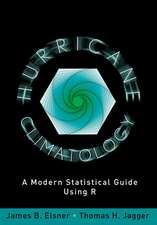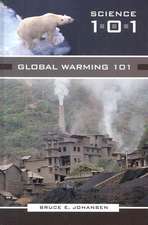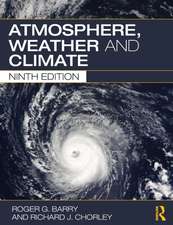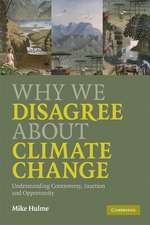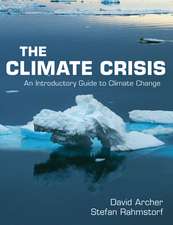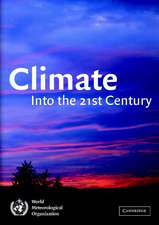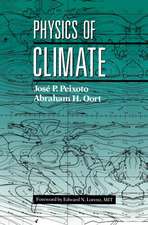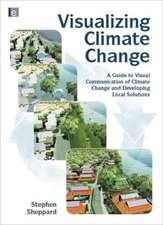Hurricanes and Climate Change
Editat de James B. Elsner, Thomas H. Jaggeren Limba Engleză Paperback – 29 oct 2010
A Summit on Hurricanes and Climate Change was held during the spring of 2007 on the island of Crete that brought together leading academics and researchers on both sides of the scientific debate to discuss new research and express opinions about what will happen in the future with regard to hurricane activity. This proceedings volume highlights the state-of-the-science research into various aspects of the hurricane-climate connection. It is likely that the science presented here will lead to new research that will help answer crucial questions about our sustainable future.
| Toate formatele și edițiile | Preț | Express |
|---|---|---|
| Paperback (1) | 951.29 lei 6-8 săpt. | |
| Springer Us – 29 oct 2010 | 951.29 lei 6-8 săpt. | |
| Hardback (1) | 959.98 lei 6-8 săpt. | |
| Springer Us – 26 noi 2008 | 959.98 lei 6-8 săpt. |
Preț: 951.29 lei
Preț vechi: 1160.10 lei
-18% Nou
Puncte Express: 1427
Preț estimativ în valută:
182.05€ • 189.36$ • 150.29£
182.05€ • 189.36$ • 150.29£
Carte tipărită la comandă
Livrare economică 14-28 aprilie
Preluare comenzi: 021 569.72.76
Specificații
ISBN-13: 9781441934741
ISBN-10: 144193474X
Pagini: 440
Ilustrații: XX, 380 p. 25 illus.
Dimensiuni: 155 x 235 x 23 mm
Greutate: 0.61 kg
Ediția:Softcover reprint of hardcover 1st ed. 2009
Editura: Springer Us
Colecția Springer
Locul publicării:New York, NY, United States
ISBN-10: 144193474X
Pagini: 440
Ilustrații: XX, 380 p. 25 illus.
Dimensiuni: 155 x 235 x 23 mm
Greutate: 0.61 kg
Ediția:Softcover reprint of hardcover 1st ed. 2009
Editura: Springer Us
Colecția Springer
Locul publicării:New York, NY, United States
Public țintă
ResearchCuprins
Detection and Attribution of Climate Change Effects on Tropical Cyclones.- Electrification in Hurricanes: Implications for Water Vapor in the Tropical Tropopause Layer.- Long-Term Natural Variability of Tropical Cyclones in Australia.- Statistical Link Between United States Tropical Cyclone Activity and the Solar Cycle.- Five Year Prediction of the Number of Hurricanes that make United States Landfall.- A New Index for Tropical Cyclone Development from Sea Surface Temperature and Evaporation Fields.- Probability of Hurricane Intensification and United States Hurricane Landfall under Conditions of Elevated Atlantic Sea Surface Temperatures.- Wavelet-Lag Regression Analysis of Atlantic Tropical Cyclones.- Network Analysis of U.S. Hurricanes.- Migration of the Tropical Cyclone Zone throughout the Holocene.- Aerosol Effects on Lightning and Intensity of Landfalling Hurricanes.- Response of Tropical Cyclogenesis to Global Warming in an IPCC AR4 Scenario.- Risk of Tropical Cyclones over the Mediterranean Sea in a Climate Change Scenario.- A Fast Non-Empirical Tropical Cyclone Identification Method.- Boundary Layer Model for Moving Tropical Cyclones.- Changes in Tropical Cyclone Activity due to Global Warming in a General Circulation Model.- Relationship between ENSO and North Atlantic Tropical Cyclone Frequency Simulated in a Coupled General Circulation Model.- Modeling of Tropical Cyclones and Intensity Forecasting.- Roadmap to Assess the Economic Cost of Climate Change with an Application to Hurricanes in the United States.- The Science and Politics Problem: Policymaking, Climate Change and Hurricanes.
Notă biografică
James B. Elsner is a Professor of Geography at Florida State University where he teaches about climate and statistics. He received his Ph.D. from the University of Wisconsin-Milwaukee in 1988 and earned tenure in the Department of Meteorology at Florida State University in 1996. His research interests include the hurricane hazard and statistical modeling. He has written over 75 research articles in scientific journals and two books. His latest book on hurricanes and climate is available from Oxford University Press. Dr. Elsner is the President of Climatek; a company that develops models for hurricane risk analysis.
Thomas H. Jagger is Vice President of Climatek and an independent research scholar.
Thomas H. Jagger is Vice President of Climatek and an independent research scholar.
Textul de pe ultima copertă
Hurricanes are nature’s most destructive agents. They have recently been linked to changes in climate. A 4-day international summit on hurricanes and climate change took place in 2007 to discuss and debate various scientific issues related to this important topic. There were 77 attendees from 18 different countries who participated in the summit.
This book is a sample collection of papers from talks that were presented. The chapters are organized around the broad hurricane-climate themes of empirical evidence, statistical methods, and numerical models. A major focus of the conference was the importance of statistical models for understanding how hurricane activity is changing and may change in the future. Emphasis was also placed on evidence of low-frequency swings in hurricane activity using historical and geological records. Results from various high-resolution numerical models, including a 20-km mesh model, were consistent in showing stronger hurricanes in a warmer future. Most numerical models indicate an overall decrease in the number of storms attributable to greater atmospheric stability and to a decrease in vertical mass flux.
This book is unique in its scope drawing from an international community of scholars in the field of hurricane climate science. The science addresses a variety of perspectives ranging from the microphysics of lightning to geological evidence of prehistoric storminess.
This book is a sample collection of papers from talks that were presented. The chapters are organized around the broad hurricane-climate themes of empirical evidence, statistical methods, and numerical models. A major focus of the conference was the importance of statistical models for understanding how hurricane activity is changing and may change in the future. Emphasis was also placed on evidence of low-frequency swings in hurricane activity using historical and geological records. Results from various high-resolution numerical models, including a 20-km mesh model, were consistent in showing stronger hurricanes in a warmer future. Most numerical models indicate an overall decrease in the number of storms attributable to greater atmospheric stability and to a decrease in vertical mass flux.
This book is unique in its scope drawing from an international community of scholars in the field of hurricane climate science. The science addresses a variety of perspectives ranging from the microphysics of lightning to geological evidence of prehistoric storminess.
Caracteristici
This book is unique in its scope drawing from an international community of scholars in the field of hurricane climate science The science addresses a variety of perspectives ranging from the microphysics of lightning to geological evidence of prehistoric storminess

